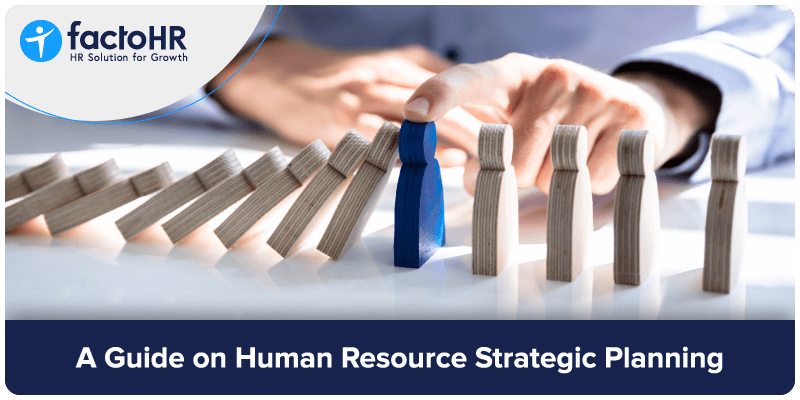Strategic Human Resource Planning: a Complete Guide (2025)

Table of Contents
We often wonder: What separates well-reputed brands from other businesses? Is it capital? Investors? Or infrastructure? Strategic HR management makes the difference between sustainable growing businesses and the rest. This proves that Strategic Human Resource Planning (SHRP) is critical.
Around 84% of organizations believe workforce planning is essential for success. However, only 43% think they have effectively implemented the strategic HRP process. This establishes that most organizations are aware of the significance of strategic human resource management (SHRM) and that only half of them can implement it successfully.
Effective HR planning facilitates long-term goal alignment and contributes to the sustainable growth of your business. In this blog, you’ll learn about the meaning, importance, and step-by-step process of implementing strategic HR planning. You’ll also get to know the challenges and best practices in SHRP.

What is Strategic Human Resource Planning (SHRP)?
Strategic Human Resource Planning (SHRP) is a long-term process that involves analyzing the current environment, forecasting future needs, and collaborating with various departments for better goal alignment. It calibrates short-term and long-term strategies for meeting business outcomes. In the short term, resources, workloads, and employee schedules are aligned with strategic HRP for handling daily concerns. In the long term, strategies across various departments, such as finance and marketing, are aligned, helping you stay relevant and competitive.
Strategic HRP covers various aspects, such as recruitment, performance management, employee development, and emergency and disaster planning. Thus, SHRP addresses current concerns and helps plan for the future by aligning human resources with organizational goals.
Why Businesses Need Strategic HR Planning?
Strategic HR planning is a must for any organization for several reasons.
- It helps reduce turnover-related costs. A proactive, data-driven approach to strategic HR planning results in lower employee turnover due to desirable role fits. Strategic HRP and predictive analytics can reduce employee turnover by up to 25%.
- Strategic HRP facilitates future-ready talent acquisition. According to a LinkedIn Global Talent Trends report, 69% of high-performing companies utilize it to anticipate future needs.
- Provides solutions to workforce shortages and skill gaps. Audits conducted as part of SHRP help HR managers analyze skill gaps and employee shortages.
- Properly planned and executed strategies result in smoother goal alignment and increased employee productivity.
- Contributes to organizational agility. Organizations with well-implemented strategic HR planning are more agile and future-ready for technological disruptions or shifts in customer needs.

What are the Main Steps of Strategic HR Planning?
The five main steps include auditing your current workforce, forecasting future talent needs, conducting gap analysis, developing a strategy, and monitoring the implementation.
1. Auditing Your Current Workforce
Auditing your current workforce is quintessential as it helps assess employees’ skills, understand potential risks, and identify skill shortages and surpluses. It facilitates a comprehensive evaluation of your organization’s existing capabilities.
2. Forecasting Future Talent Needs
Needs forecasting involves supply and demand forecasting. Supply forecasting evaluates the current workforce by considering market trends and current headcount to provide estimates related to hiring needs. Demand forecasting helps you understand your organization’s future labor needs. It also predicts required skills and roles based on changing market patterns and technological advancements.
Any type of future planning requires a thorough understanding of your human capital and the industry for accurate need forecasting. Capabilities such as predictive analytics could significantly improve all aspects of needs forecasting. Historical data, machine learning, and advanced statistical algorithms could provide more accurate information about various trends and patterns.
3. Conducting Gap Analysis
77% of HR leaders think their organizations face critical skill gaps. This makes conducting gap analysis even more significant.
Gap analysis utilizes the results of the first two steps. It compares the current workforce’s skills and numbers with the future talent needs, helping to identify gaps. Gap analysis helps understand your organization’s current needs, such as upskilling, new hiring, or necessary reskilling.
For example, a digital marketing agency looking to hire recruits might conduct a gap analysis and realize that it has enough employees for social media marketing and needs to hire recruits for SEO. At the same time, it has some employees who could be reskilled for a particular role.
4. Developing a Strategy
In this step, different strategies for addressing different conflicts are developed.
Issues related to recruitment, talent management, and retention are addressed with the help of talent management strategies. Low employee engagement is covered under employee engagement strategies. Organizational issues such as succession planning and departmental problems are managed using organizational strategy.
Talent management issues could be addressed through recruiting, developing, and retaining talent. Employee engagement strategies can also help address low employee morale and productivity-related issues.
Measures such as skill development, direct channels for feedback, and improving overall collaboration could help address organizational issues.
Other processes, such as succession planning, which helps identify top talent for important positions, are also significant.
5. Monitor, Evaluate, and Evolve
This is the final step, but it’s not the end of strategic HR planning. Instead, monitoring different strategies is a continuous process in which Key Performance Indicators (KPIs) are evaluated. The evaluation compares KPIS with desired targets and helps decide the next action.
Evolving your strategies is also important for implementing SHRP, especially when you do not get the desired results. Monitoring progress, evaluating results of your current plan, and developing targeted strategies for specific issues could result in a more resilient, sustainable, and productive business.

Challenges and Best Practices for Strategic HRP
Lack of accurate data, unpredictability due to technological advancements, employee resistance, and potential errors in forecasting are some of the challenges associated with implementing strategic HRP.
Some solutions include using cloud-based HR software, implementing continuous learning and development programs, and leveraging predictive analytics. Clear communication also helps address employee resistance issues.
Consider the following best practices to make the most out of your strategic human resource management process–
- Utilize capabilities such as predictive analytics for decision-making.
- Ensure alignment between business goals, departmental strategies, and HR planning.
- Promote programs that increase employee engagement and overall productivity.
- Develop adaptable and flexible strategies for ever-changing markets.
- Implement programs for comprehensive succession planning and leadership development.

Conclusion
Strategic human resource management can help you meet the market’s demands and prepare your workforce for future advancements.
With strategic, data-driven insights, you can make better decisions, improve employee engagement, and boost your organizational performance.
Implement the five steps of the main process of SHRP for realizing lower employee turnover and staying competitive with other businesses.
Why Document Your Strategic HR Plan?
You should document your strategic HR plan because it–
- Ensures goal alignment and clarity.
- Provides a comprehensive and consistent framework for implementation.
- Facilitates greater accountability.
- Enhances the flexibility and agility of your strategic HRP.
- Helps mitigate risks related to audits and compliance.
What is the Difference Between HRM and Strategic HRM?
HRM and SHRM are related processes. However, they have different approaches to HR management. HRM follows a reactive approach. It resolves problems after they arise. On the other hand, SHRM is proactive. It anticipates potential issues and tries to solve them beforehand. Also, HRM operates independently from different departments, while SHRM follows a more collaborative approach in operating with other departments. HRM focuses more on administrative tasks like payroll calculation, while SHRM focuses on strategic aspects such as aligning HR management with organizational goals.
Grow your business with factoHR today
Focus on the significant decision-making tasks, transfer all your common repetitive HR tasks to factoHR and see the things falling into their place.

© 2025 Copyright factoHR


